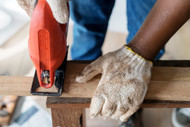Tips & Tricks for Timber Deck Maintenance
Posted by Daryl Schmidt on 29th Jun 2023
Tips & Tricks for Timber Deck Maintenance
Decks are an extension of your house where you can relax and enjoy the outdoors lounging comfortably in a chair. Timber decks are beautiful and look great as a part of your house, but timber decking boards need careful maintenance and care. Exposure to the sun, wind, rains, and even snow makes your timber decking susceptible to moisture, mildew, and wood rot. Weathered wood can lead to cracks and breaking of the decking floors. So, timber deck maintenance is required to ensure safety.
Today we look at some crucial tips for deck maintenance that will keep your timber decks looking great for many years to come.
Tips for Timber Decking Maintenance
1. Select an appropriate deck cleaning solution
Deck cleaning is an important part of timber deck maintenance. Make sure you sweep it regularly to get rid of dust and dirt. Avoid mopping as the moisture may not be suitable for it. If you need to clean it thoroughly, then use a suitable deck-cleaning solution.
Use a mild detergent that is not too harsh on the surface. Choose a deck cleaner that removes all dirt and debris and prevents any dirt build-up - without removing the stain on the decking treated pine boards.
2. Avoid moisture with decking oils or stains
Timber and water do not go well together. If your timber boards absorb too much of moisture, then it can make the wood soft. This could lead to potential rotting of the wood. The solution is to apply decking stains or oils.
They help repel water and reduce the amount of moisture that is absorbed by the wood. Use the best decking oil for spotted gum timber to keep the wood looking good and finished well.
Once your deck has been stained, remember to keep the water exposure to a minimum. Treated pine decking oil is also good for use to maintain your timber surfaces.
3. Keep an eye on your nails and screws
Timber decks typically use nails and screws to be set to the surface. Over time, these nails or screws can start rusting, or the timber may begin to push the nails out. So, during your regular inspection, if you notice any nails protruding out more than before, then get a hammer and hit the nails back to the surface.
With rusting, there can be two types of damage. First, rusted nails can lead to discolouration of the timber and give it a bad look aesthetically. And second, rusty nails can cause the timber to swell. This can cause splits or cracks in the timber.
So, keepinga close eye on your nails and screws is critical. And if you see them catching rust, then immediately replace them with new ones.
4. Address any issue or damage at the earliest
Deck maintenance should always be preventive in measure. So, you must regularly assess your timber deck and look for any damage or deterioration on the surface. From wear and tear to issues with nails and screws, always solve issue as soon as possible.
The good thing about timber decks is they are resilient. One small damage will not cause it to fall and break down, so maintenance can be done slowly and steadily. But make sure that you do not knowingly neglect any damage.
5. Stain your deck; do not paint it
Do not paint your decks. While protecting your walls from moisture damage may be helpful, it does not work well for decks. Timbers are unsuitable surfaces to hold a layer of paint and start flaking or peeling after some time.
Staining your deck is an essential part of deck maintenance. The timber absorbs the stain well, and it helps in repelling water and enhances the natural colours of the wood. So, deck stains protect the surface and also make it look good.
How often should you stain your deck - this depends on various factors like the climate, the age of your timber, the type of timber, etc. If you notice that your deck appears dull and the timber seems to be absorbing more water than usual, it is likely in need of a fresh coat of stain.
At Canterbury Timbers, we supply an extensive range of timber decking products, including hardwoods, composite woods, and more. Check out our various offerings at our website.

